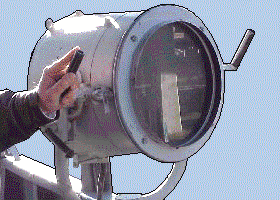|
I'm going to digress this month, because
over the past few days several people have sent me news articles
regarding the end of ex-USS GAGE APA168.
"NEWPORT NEWS, Va. - The USS
Gage departed the James River Reserve Fleet Thursday, headed to Esco
Marine, Inc., in Brownsville, Texas, for recycling.
According to the Department of the Navy's Naval Historical Center, the
attack transport USS Gage was commissioned in November, 1944. During
World War II, the Gage participated in the initial assault on Okinawa in
April, 1945, landing men and supplies for five days despite nearly
continuous alerts of Japanese suicide attacks. She was decommissioned in
Norfolk in February, 1947, and transferred to the Maritime
Administration Reserve Fleet in September, 1958. Esco Marine, Inc. was
awarded a contract to recycle the Gage on July 3rd. The Gage
is the 81st ship to leave the James River Reserve Fleet since January 1,
2001. "
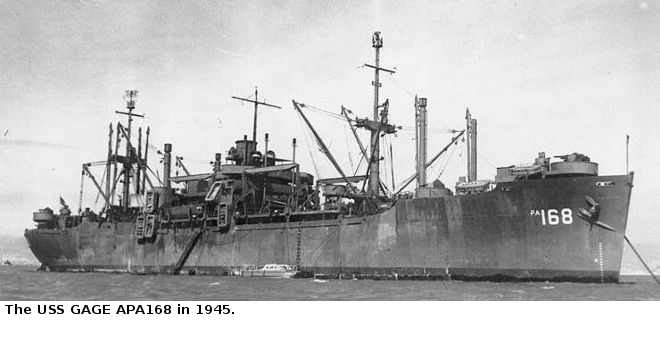
I feel a need to write a proper obituary
for this ship. She has been a
part of my life since I first discovered her in rusting away in the
James River Reserve Fleet in 1989. For the past twenty years she has
clung to life, a true ship that would not die. Few ships have given more
to the historic fleet than GAGE, and for that she deserves to be
remembered. But a proper obituary would take weeks of research and a lot
more time than I have. But if I write the story into the gossip sheet
called SLATER SIGNALS, no research is necessary, because everyone knows
better than to believe what they read here. Itís all gossip, hearsay
and legend. Parts of the GAGE live on in many vessels in the current
historic fleet.
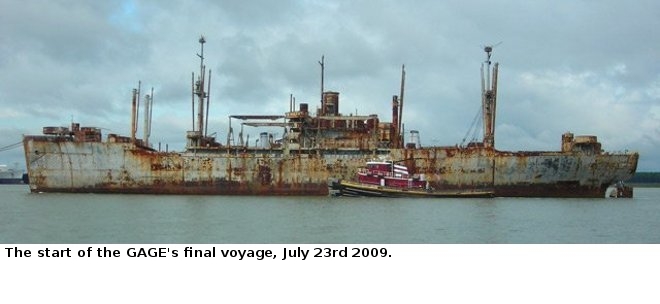
Back in 1989, when I was Shipís
Superintendent aboard the old KIDD DD661 in Baton Rouge, I made my
annual call to Inactive Ships Portsmouth to inquire about ships
available for stripping. I
believe it was Fred Hood who I talked to. Fred mentioned that
they had pallets of 20mm magazines on the pier coming off a WWII attack
transport that was being fleet stripped, I nearly flipped out. The ship
was the ex-USS GAGE APA-168, pierside in Portsmouth being readied for
disposal. Nate Bergeron and I rented a 24í Ryder truck and put
a trip together in record time. It was on this first trip that we
enlisted the aid of Rear Admiral Alan Roby, KIDDís plankowner CO, who
had retired to Portsmouth. He had arranged to bring in Navy volunteers
from the cruiser SOUTH CAROLINA, and attended the meetings with the
folks from Global and Inactive Ships Navy side to smooth things over.
KIDDís WWII gunnery officer George Wrocklage, and former
crewmembers Eppa Barkley and torpedoman Russ Pribble also
volunteered.
As theyíd say in Vegas, we hit the
jackpot on GAGE. She was
pierside in Portsmouth where removals were easy. She had not seen any
service since 1946, and still had here complete WWII fit of radar
electronics, radio gear, mess gear, a veritable time capsule. Treasures
were palleted all over the wharf. While all the guns were gone, she
still had all the 20mm magazines, tools, MK 51 directors, MK 14
gunsights, and something that haunts me to this day, an optical
rangefinder and pedestal stowed in the wardroom. It was one of the most
successful scavenging trips weíd ever been on. Among the GAGE items
now on display on KIDD include all the WWII era spring bunks, mess
tables and benches, the sky lookout chairs on the flying bridge, the SG
radar console and horizontal plotting table in CIC, 6 20mm ready service
ammunition lockers all filled with 20mm magazines troughs to restore the
heads and enough WWII era incandescent light fixtures to convert the
whole KIDD from fluorescent lighting.
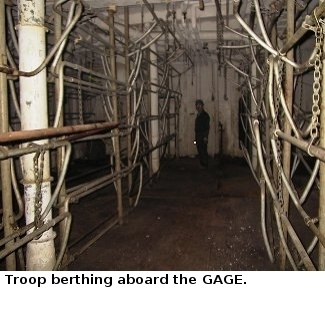
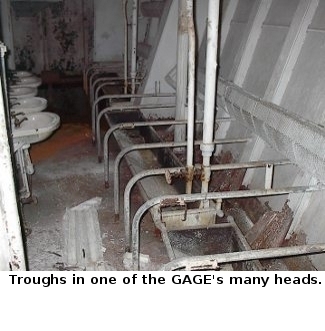
At the same time, we pulled parts from
two other sister APAs. moored in the stream with the James River Reserve
Fleet, LAUDERDALE APA179 and LAVACA APA180, all three intended for rapid
disposal. We made limited removal from those two, as well as the Gearing
class FRAM WILLIAM C. LAWE DD763. But GAGE was the real prize. Between
1989 and 1997 we continued to make continual runs on the GAGE. We were
indebted to Navy Lt. John Gaffe, Lt. Ken Peldunas, and
STGCM Bradshaw who removed a great deal of additional equipment
from the three ships and shipped it to Baton, including additional light
fixtures, radio gear and radar parts. They even were featured in an
article in the Newport News Naval Station Newsletter for their efforts.
>In
1992 the GAGE crew held a reunion and presented KIDD with a plaque to
identify the parts from their ship. At that time I learned I had a
personal link with GAGE. In
1969, I made my first ocean going voyage on the mighty ocean liner SS
UNITED STATES during her last year of service. As a lowly mess attendant
in the deck department mess, I never met the Captain, but he was Leroy
J. Alexanderson, Commodore if United States Lines. It turned out
that Captain Alexanderson had been the plankowner CO of GAGE in 1944 and
commanded the Gage at Okinawa,
landing elements of the 6th Marine Division. Small world.
Sometime in the mid nineties, we were
approached at the Louisiana Naval War Memorial by a private contractor
who wanted to purchase the 40mm fire control amplifiers off the KIDD.
It seems they had a contract with the Taiwanese Navy to overhaul their
active 40mm directors systems. Having plundered so many other ships for
parts, we were very protective of our own and I directed them to the
GAGE, suggesting that the amplifiers they were seeking were no doubt in
the forward and aft deck houses under the empty 40mm tugs. I later
learned that they were successful in finding the parts and completing
their contract. I should have demanded a finderís fee, but I guess
this explains why Iíve spent my career in the not-for-profit sector.
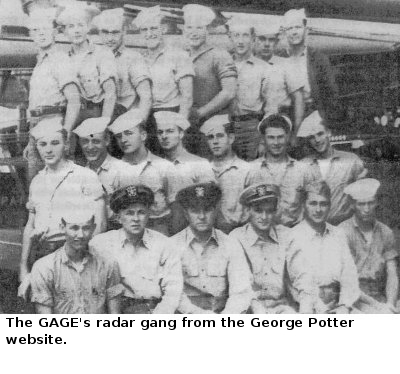
In 1993 I was asked to come to New York
to do a survey of the SLATER and make a list of all the items that would
be needed to restore her to her 1945 condition.
The ship was a stripped out shell on the inside, but outside she was
still a World War II DE with all her ordnance and configuration. With
fifteen years of ship stripping under my belt, I had a good idea of
where all the parts the SLATER needed were, and most were on the GAGE.
Over the next several years, I volunteered to help the Destroyer Escort
Historical Museum identify parts from the GAGE that would be useful for
SLATERís restoration. GAGE gave SLATER the same kind of material she
gave to KIDD. They paid Global to remove the large parts and stored them
in a facility in Portsmouth. The large parts included the SA air search
radar console, the SA radar antenna, a VD-2 radar repeater, TDE and TAJ
radio transmitters, two radio operatorís tables, a sterilizer for
sickbay, a portable sterilizer for the wardroom. Over the coming years,
the smaller parts include radio receivers, antennas and patch panels,
the four sky lookout chairs, troughs and trough seats, washroom mirrors,
bunks and chains, the Hobart dough mixer, dozens of light fixtures, all
kinds of speakers and amplifiers, compartment fans, desk lights, and
MK14 gunsights and compressors. SLATERís whole radio room is restored
with many of GAGEís radios.
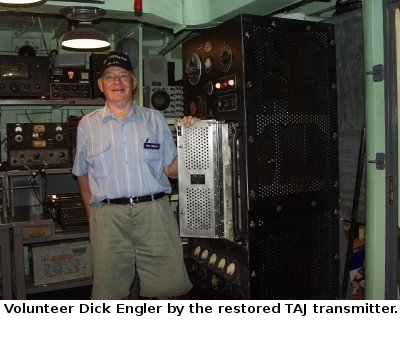
In August of 1999 Pat and Frank
Perrella, DE-326 traveled to Baltimore to make a cruise on the restored
Liberty Ship JOHN W BROWN. They found that the BROWN crew has
squirreled away the optical rangefinder from the USS GAGE, a four-foot
model as opposed to the seven footer the DEís used. Unfortunately, the
rangefinder pedestal that I saw in the GAGEís wardroom was never
found. Frank and Gordon Lattey made a run down there after the BROWN
crew donated it to us and in 2002 we hoisted it aboard. The rangefinder
tube sat on the 01 level under canvas for a long time until Hal
Hatfield had the guys in his shop fabricate the platform for
the rangefinder based on dimensions Cliff Woltz got
from the USS STEWART in Galveston, and a sketch Dick Walker
worked up. Well, along came the late Roy Lustenader, a
former fire control man off
USS STORMES DD780. Roy took all the data we had on the
rangefinder, sketched up a plan for a pedestal and found a good Samaritan
to build it for us out of three-eighths-inch plate. Doug
Tanner arranged for a crane to hoist the rangefinder tube, pedestal
and platform to the flying bridge when we were pierside in Rensselaer.
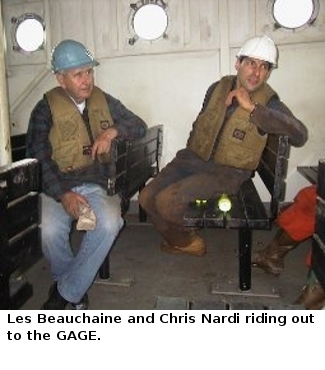
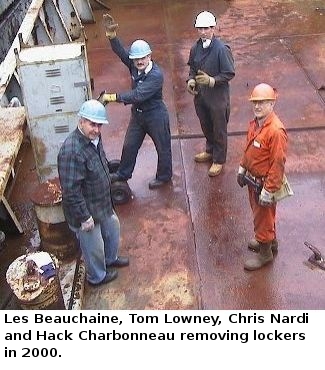
In May 2000 we sent the late Hack
Charbonneau, Les Beauchaine, Doug Tanner and Jerry Jones back down to
the GAGE. Jerry Jones
described the experience of being aboard the GAGE as "Being on
board in the total dark and silence was almost a spiritual experience
for me, especially below in the troop berthing compartments where too
many of the soldiers and marines spent their last days. The pictures
canít begin to capture it. I cannot begin to really describe the
experience of being there." They came back with a truckload of
needed electrical fittings, a copper for the galley, and 25 bunk frames,
hooks and chains needed for the aft crew's quarters. It took until May
of 2001 for the Michigan Crew to do the sanding and painting on all the
steel frames. By August 2001 Russ Ferrer took charge of
rebuilding the mast-mounted bullhorn that enabled the 1MC to project
over the water to other ships. He restored the eight speakers, which
were a mass of rust and replaced the entire housing, which had holes
from years in storage in the pilothouse of the old USS GAGE. In
August 2003 we finally got around to installing the GAGEís big
autoclave that we had salvaged about ten years earlier. This piece of
equipment had been in storage in Virginia for several years, before
trucking it to Albany in 1998. It was stored at the Port until they tore
down the shed, then Bob Cross kept it at the City water tower
until we were ready for it. Paul Czesak picked it up that month,
and Larry, Don Shattuck, Dave Floyd and the big guy Tommy
Moore got it aboard and managed to get it down the ladder and into
sickbay. That's the last big piece of gear to make the space complete.
We and many other historic ships continued to make trips and find
treasures.
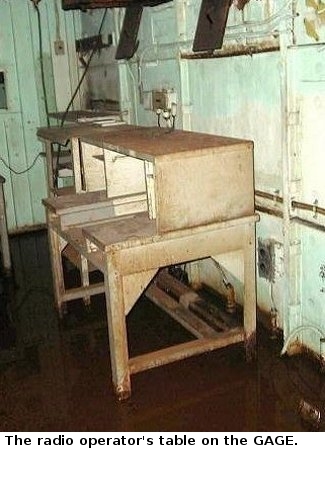
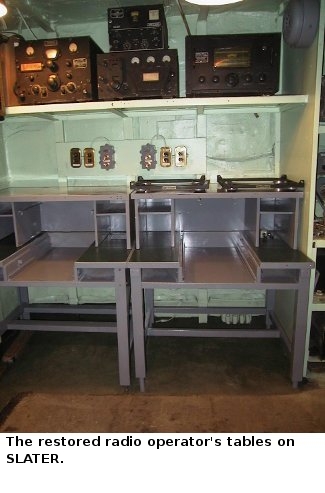
By Feb 2008 we knew that time was
running out and Greg Krawczyk organized
two trips to the James River Reserve Fleet Bill Siebert and Will
Donzelli went down on our behalf. Since the USS GAGE was a dead
ship, it was one of the few chances to obtain electrical fittings such
as fuse boxes and more light fixtures. That April Barry Witte and
Gordon Lattey led a group of volunteers to the Fleet for the spring
strip trip. They were assisted by a group of sailors from the carrier
USS THEODORE ROOSEVELT CVN71. The parts ranged from mess benches to
light fixtures, to old style lockers.
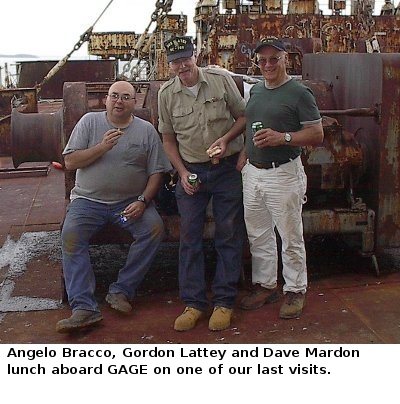
In September 2008
Gordon Lattey led a final expedition to the James River to the USS
GAGE. The Maritime Commission gave us permission to take some
watertight doors off the second deck, something that is very rare
indeed. In the past, we have never been allowed to disturb a vessel's
watertight integrity. We had to work fast, because the ship was open for
bid inspections on September 15th, and that left us with one
week to put the trip together and grab the doors. Once bid inspections
begin, no removals were permitted. The GAGE has the same style quick
acting doors as SLATER, so MARAD relented and let us take a six prior to
the vessel being bid for scrap. Bill Siebert, Bill Houghton, Dave
Mardon and Angelo Bracco joined Gordon for the trip down. In
one day they staged six doors on the fantail for removal.
LAVACA was sold for scrapping in 1992.
Around that time the rules changed. Congress ruled that all hazardous
materials had to be removed from ships before they could be scrapped
overseas. Since remediation was so expensive, and scrap prices were so
low, the market dried up and ship scrapping ground to a halt. It took
Congress several years to fund the scrapping program that in effect paid
the remediation costs from ship recyclers. Thus ships that should have
been long gone were left rusting at their moorings, GAGE among them.
LAUDERDALE had an odder fate, bid out to a "recycler" who was
to remove all the "Valuable Material" and return the hull to
the fleet for future scrapping. This particular "Recycler" was
only interested in all the steel he could get without raising the HAZMAT
issue, and the hulk that was returned to the fleet represented the most
dangerous vessel present. We were never again permitted aboard. It took
several more years to dispose of her, and she was finally scrapped in
the spring of 2005 by North American Ship Recycling, in Sparrows Point,
Maryland. My Friend Chris Nardi, Curator of the Battleship
Massachusetts made one last run on her while she was at the breakers. 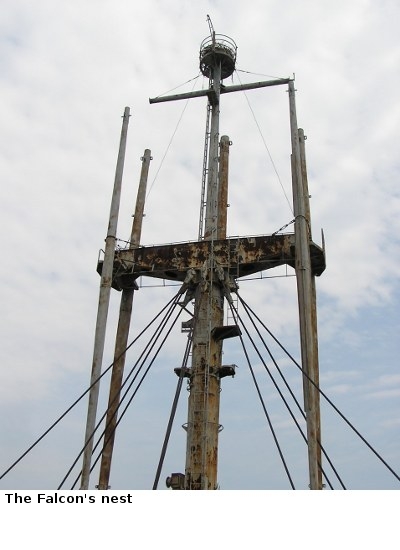
The Navy decided that GAGE would make an
excellent target ship, and plans were made to tow her back to Portsmouth
for additional remediation. At
that point, a peregrine falcon, on the endangered species list decided
that the GAGEís mast would make an excellent nesting point, and
homesteaded the GAGE. Movement of the ship was postponed until the eggs
were hatched and a new generation of peregrines went winging away.
Hereís where the wheels of government turn slowly, and before the ship
could be moved again, the peregrines were back. I canít remember if it
was the third or fourth year that the maintenance crew told stories of
climbing the mast and tossing the nesting material down to the deck. I
believe it took four years for the Navy to beat the falcons at get the
ship down to Portsmouth again for another round of remediation. Prior to
her departure from James River, I made a run up there and staged a pile
of scarce 40mm gun parts in an officer stateroom in the superstructure.
I tagged the lot by placing one tag on a sound powered phone box that
said "Hold for USS KIDD."
The next time I saw her, she was
pierside in Portsmouth, and all the rules had changed.
All of a sudden my beloved old ship was an active hazardous waste site.
The ship was crawling with workers fully suited out in Tiveks and
respirators. Large tanker trucks were on the pier and forty years of
pigeon droppings were pressure washed from her decks. I wanted to get up
to that stateroom to receive the parts we had staged, but was denied
entry until I was trained and fitted with a respirator. I explained that
I'd been aboard the ship many times before and had somehow lived through
the experience, but that didn't cut it with the yard safety officer. The
final straw was when I was told that I'd have to shave the poor excuse
for a beard Iíve worn since 1976. It just wasn't worth going back
aboard. I directed one of my clean-shaven compatriots to the stateroom
where I had staged our treasure, and there he found a lone sound powered
phone box with the Hold for USS KIDD" tag on it, and all the other
material had been removed and disposed of. That was 1997, and we did
pick up additional 20mm ready service lockers, including several for the
Battleship Texas.

The story might have ended there, but I
was later told that the peregrine falcon found the GAGE pierside in
Portsmouth and set up housekeeping on the aft radar platform.
Whether is was the same bird or not, whether the story is true or not,
I'll never know. But the next part of the legend is that it was at that
point that the environmental cost of preparing the ship for sinking grew
to the point that all the commands that had been funding the conversion
of GAGE to a target ship threw up their hands and walked away. When this
last group of peregrine chicks were old enough to fly, back to the
anchorage went the GAGE. And now new federal regulations came into play.
The Maritime Commission was now to do historic reviews of the ships that
were being disposed of. A group started an effort to save the GAGE, and
she was placed on donation hold, a timely idea in 1989 but by 2004 it
was way too late. Municipalities were now realizing the true cost of
maintaining these relics and there were no takers.
Iíve never kept a complete list of all
the shipís Iíve stripped to restore KENNEDY, KIDD and now SLATER,
but among them in addition to GAGE, LAVACA and LAUDERDALE are CAPERTON,
GLENNON, ROBERT L WILSON, WRIGHT, SPRINGFIELD, NORTHAMPTON, RALEIGH,
TOLMAN, DONNER, WABASH, NEMASKET, SAUGATUCK, CHIPPEWA, WILLIAM C. LAWE,
WILLIAM WOOD, NELSON M. WALKER, GENERAL MAURICE ROSE, GENERAL POPE,
LORRAIN COUNTY, SPHINX, CLAMP, NEWPORT NEWS, DESMOINES, PETREL,
KITTIWAKE, SUNBIRD, PRESERVER, BASILONE, FORRESTAL, VULCAN, MOSOPELEA,
STRIBLING, HARRY E YARNALL, LASALLE, RANGE SENTINEL, SANTA BARBARA,
SPERRY, SPIEGAL GROVE, HOWARD W. GILMORE and two ATAís that I never
could learn the names of. I
present their names here only so that they are remembered for their
contributions to the historic fleet. The ones that stand out in my mind
are the time capsules; the ones that laid up right after the war and
never saw any postwar service. Those are the ones I felt most guilty
about. I didn't feel guilty about the GAGE when I first found her, but
the longer I stripper her, the worse I felt. She lasted twenty years
longer than she should have, given a reprieve by environment regulation
and the legalities of the historic review. No ship gave more to the
historic fleet than GAGE. For those interested in learning more, our
friend Russ Padden has a webpage devoted to her at http://www.rpadden.com/168/168gage.htm
We will always be indebted to the Navy
and Maritime Commission who supported out operations over the life span
of the GAGE. It is a sad thing
to see her go the last of her breed, and she deserves to be remembered
as a ship that kept on giving long after her service days were over. USS
GAGE will always have a special place in my heart. When you visit
the Albany and see the GAGEís air search radar rotating atop
SLATERís mast, remember this fine ship and her crew, and the marines
who went down her disembarkation nets. |
